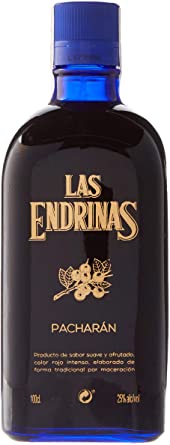Pacharán: Basque Sloe Brandy
- hacerestrago
- Dec 2, 2020
- 2 min read
Updated: Feb 2, 2021

On a hot July night in Marbella, a Costa del Sol town in the southern Andalusia region of Spain, we were invited to a dinner on a magnificent rooftop a few miles away from the Puente Romano Hotel where we were staying. Overlooking the Mediterranean sea, we were served chilled glasses of brandy, a welcomed digestif given the heat. The brandy was so exceptional that we remember almost nothing else about the dinner! Now, to be fair, any beverage served on a rooftop overlooking the Mediterranean will in fact be fantastic, but this brandy is uniquely delicious even away from paradise.
We learned it was pacharán brandy—also known as patxaran—made from crushed and fermented berries of the sloe/blackthorn tree. Our generous hosts informed us they were 'wild beach plums', although these plum-colored berries in the rose family are actually cultivated in the northern Basque region of Navarra where pacharán is produced. The cloudless red brandy is fresh, sweet, and succulent given the remarkable flavor of the fruit. In addition, anise is added offering a whispered fragrance of licorice to the liqueur that is uninterrupted by any scent of alcohol. Some producers add coffee beans for subtle, almost indiscernible, richness while others include lemon, orange, or grapefruit for an effervescent twist of citrus. Though the flavors vary, the process for producing pacharán is strict, dictating the quantity of sloe and the time frame for maceration which ensures that each bottle meets the standards and expectations of the governing body and anyone lucky enough to savor the pacharán.

It should come as no surprise that, given the magnificent flavour, pacharán has been enjoyed by the Spanish for centuries.
We know this as there are records of the liqueur being served as part of the wedding menu for the marriage of Gonofre de Navarre, the son of the Spanish King Charles III, with Doña Teresa de Arellano, which took place in 1415. We also know that the Queen, Blanca I, took pacharán for its medicinal properties when she fell ill at the Monastery of Santa María de Nieva in 1441 (1)
You can be confident that a bottle of this beautiful red liqueur, favorited by royalty, will impress any guest on your list. There are no shortage of producers of pacharán; Zoco, Panizo, La Navarra, Etexko are just a few although Zoco seems to be the most readily available. Should you purchase a bottle of pacharán to gift, be sure to buy an extra bottle for yourself and let it transport you to a hot summer night on the southern coast of Spain.















Comments